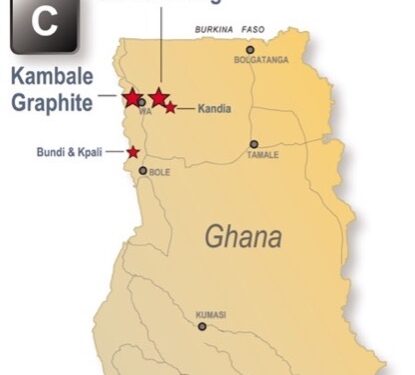Junior explorer Castle Minerals Limited (ASX: CDT) has commenced a four-hole, 370m diamond core drilling programme at its emerging flagship Kambale graphite project, Ghana, to retrieve samples for Phase 2 test work aimed at producing a fine flake graphite concentrate that could be sold for use in the manufacture of electric vehicle battery anodes.
A follow-on 31-hole, 2,460m RC drilling programme is aimed at better defining high-grade graphitic schist zones and for infill purposes to support a maiden JORC 2012 Mineral Resource estimate scheduled for end-Q1 2023.
“We continue to fast-track the emerging Kambale graphite project with a diamond core drill programme commencing just days after reporting results from a recently completed RC drilling campaign which successfully extended the Kambale deposit’s north-south axis to 2.5km,” Managing Director, Stephen Stone, said.
“We plan to have the core drilling and a follow-on 31-hole infill RC drilling completed by early-December and core samples in Perth ready to start Phase 2 test work by Christmas.
The test work will aim to produce a fine flake graphite concentrate suitable for use in the manufacture of electric vehicle battery anodes.
“Our consultants should deliver an independent Exploration Target estimate by end- November and we plan to provide a maiden JORC 2012 Mineral Resource by the end of Q1 2023. So, just with Kambale alone there is a lot for Castle’s shareholders to look forward to in the near-term.”
Castle recently reported results from the final 29 holes of a 52 hole, 5,353m RC drill programme where mineralisation comprising a series of sub-parallel graphitic schist zones was confirmed to extend north- south for 2.5km.
Several of the RC holes returned thick, high-grade and multiple intercepts of graphite with results overall reinforcing expectations that ultimately a series of higher-grade zones will be outlined within a broader but still well mineralised envelope.
Core drilling and test work
The diamond drill core will be obtained from four locations providing a good representation of the graphite schist material and its variability.
Phase 1 test work was conducted on near-surface, trench excavated material where weathering of the graphite and gangue material will have impacted the mineralogy and subsequent concentration process.
The weathering profile is observed to extend to a depth of 30-40m below surface. Fresh graphitic schist has been drilled to a vertical depth of at least 100m and remains open at depth.
Phase 2 test work will comprise a series of beneficiation, flotation and grinding cycles on composited core to develop a preliminary process flowsheet design aimed at producing a commercial grade fine flake graphite concentrate for possible application in electric vehicle battery anode manufacture.
The rock density, structural integrity and other attributes of the core will be measured for use in the proposed Mineral Resource estimate and in any mining scoping studies, should they be warranted.
Exploration Target
An independent Exploration Target estimate based on the recently completed and historical drilling is planned to be delivered by end-November 2022.
The Kambale graphite deposit was identified in the 1960s by Russian geologists prospecting for manganese. They undertook a programme of trenching and drilled 25 holes to a maximum depth of 25m. A subsequent report noted “two main zones of graphitic schists averaging around 10% to 15% graphite within which there were higher grade zones and that the graphite is the flaky variety with fine crystals (usually less than 0.25mm).
For further information please visit: https://www.castleminerals.com/












